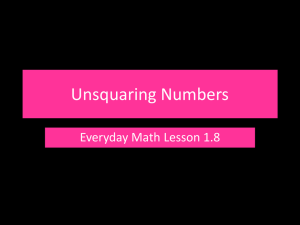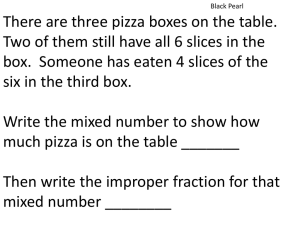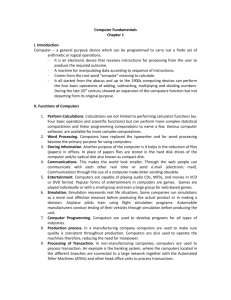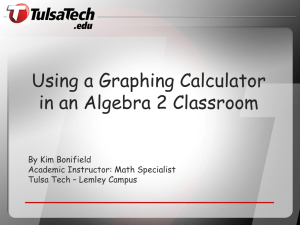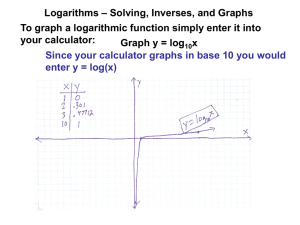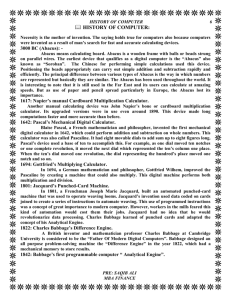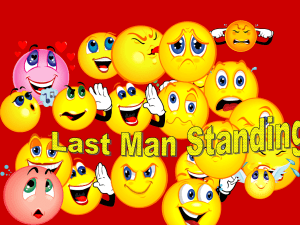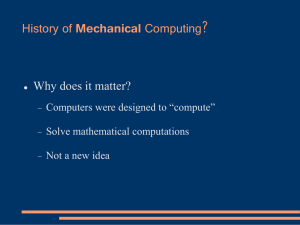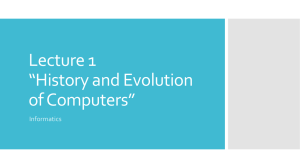History of Computing: Generations & Key Milestones
advertisement
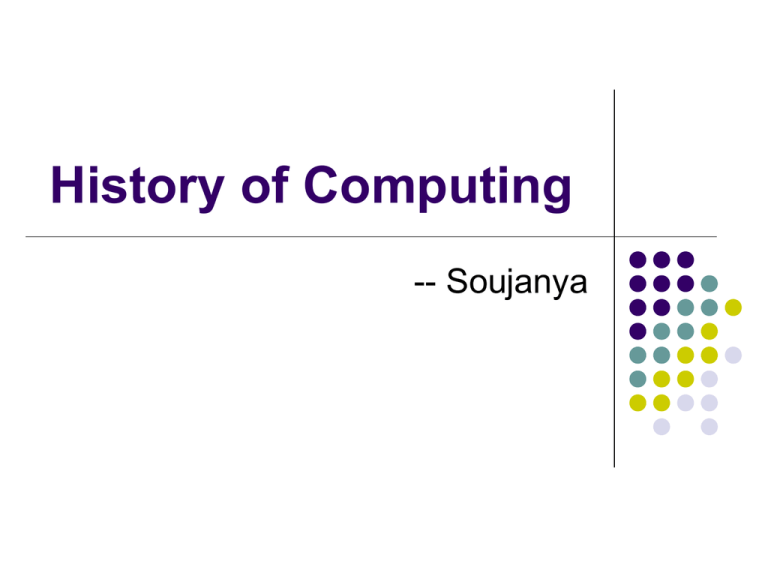
History of Computing -- Soujanya Contents Definition Abacus(600 B.C) Cardboard Calculator First Calculator Difference Engine(1822) Well-Known Early Computers The Computer Generations & their characteristics Definition Computing : It is a study of systematic processes that describes & transform information: their theory, analysis, design, efficiency, implementation & application. Abacus(600 B.C) Also known as “Soroban”. Represents the numbers by the position of the beads. Simple addition and subtraction carried out rapidly and efficiently. Abacus Cardboard Calculator It was designed by John Nepier in the early 17th century. Nepier Calculator He invented logs in 1614. Logs allowed multiplication and division to be reduced to addition and subtraction • First Calculator • Wilhelm Schickard designed the 1st mechanical Calculator in 1623 • Schickard calculator The first mechanical adding machine was invented by Blaise Pascal in 1642 Pascaline Contd.. In 1671, Baron Gottfried of Germany invented the first calculator for multiplication. Later, Herman Hollierith came up with the concept of punched cards. Difference Engine(1822) Charles Babbage designed a “Difference Engine” in 1822 which could produce reliable tables. In 1842, Babbage came out with his new idea of “Analytical Engine” Capable of performing the basic arithmetic functions. Average Speed of 60 additions per minute. Contd.. Difference Engine Well-Known Early Computers The Mark I Computer(1937-44) First fully automatic calculating machine. Designed by Howard A Aiken. Electro-mechanical device Though reliable, it was very complex in design and huge in size. Capable of performing 5 basic arithmetic operations:’+’ ‘ - ’ ‘ * ’ ‘ / ‘ and table reference. The ENIAC(1943-46) The Electronic Numerical Integrator Analysor & Calculator (ENIAC) was the first electronic computer. It used 18000 vacuum tubes Addition of 2 numbers achieved in 200 microsec Multiplication in 2000 microsec. Could store & manipulate only very limited amount of information Its programs were weird on boards. The EDVAC(1946-52) Electronic Discrete Variable Automatic Computer. Designed on stored program concept. The EDSAC(1947-49) The Britishers developed the Electronic Delay Storage Automatic Calculator (EDSAC) Addition operation accomplished in 1500 micro sec. Multiplication operation in 4000 micro sec. Manchester Mark I (1948) Experimental machine based on stored program concept Storage capacity was only 32 words, each of 31 binary digits. Hardly of any practical use. The UNIVAC I (1951) The Universal Automatic Computer (UNIVAC) was the first digital computer. Introduced in 1951 Used continuously for 10 yrs. Note: Later in 1952, IBM corporation introduced 701 commercial computer. The Computer Generations First Generation Computers(1942-55) ENIAC EDVAC EDSAC UNIVAC I IBM 701 Characteristics of First Generation Computers They were the fastest calculating devices of their time. They were too bulky in size. They should be properly air-conditioned. The power consumption was very high. They were prone to frequent hardware failures. Constant maintenance required. Commercial production of these computers was difficult and costly. They had limited commercial use. Second Generation Computers (1955-64) Bell Laboratories invented a new electronic switching device called ‘Transistor’ in 1947. High-level programming Languages like FORTRAN, COBOL, ALGOL & SNOBOL were developed. Characteristics of Second Generation Computers Ten times faster than the first-generation computers. Much smaller in size Consumed much less power Much more reliable and less prone to hardware failures Had faster and larger primary and secondary storage devices. Easier to program. Hence they had wider commercial use. Third Generation Computers (1964-1975) Texas and Fairchild semiconductor both announced the integrated circuit in 1959. FORTRAN & COBOL languages are standardized to FORTRAN IV & COBOL 68, also referred to as ANSI FORTRAN & ANSI COBOL. Characteristics of Third Generation Computers Much more powerful. (Performs 1 million instruction per sec) Much smaller in size. Much less power consumption. Much more reliable and less prone to hardware failures. Faster and larger primary and secondary storage devices. Totally general-purpose machines suitable for both scientific and commercial applications Contd.. Standardization of high-level programming languages allowed programs written for one computer to be easily ported to and executed on another computer. Timesharing O.S helped in drastically improving the productivity of programmers cutting down the time and cost of program development by several fold. Fourth Generation Computers (1975-1989) Micro-processors came into existence. Start of Personal Computer Revolution. P.C:Compact & inexpensive Hard-disk: Cheaper, smaller in size and larger in capacity Floppy disks became popular. LAN, WAN came into existence. Several O.S like MS-DOS, MS Windows, UNIX were developed. C , C++ programming became popular. Characteristics of Fourth Generation Computers The PCs were much more smaller and cheaper than the mainframes or minicomputers of 3rd generation. They are much more powerful. No air-conditioning was required for the PCs Consumed much less power. Much more reliable and less prone to hardware failures. Faster and larger primary and secondary storage devices. Totally general-purpose machines. Contd.. They contained graphical user interface. Availability of C programming language allowed these systems to be effectively used for systems programming also, like design of compilers and O.S Object-oriented languages allowed rapid software development. Fifth Generation Computers (1989-Present) Larger disk space Optical disks (CD-ROM) emerged. Internet came into existence. The concept of ‘Multithreading’ was introduced. Java programming gained popularity. Characteristics of Fifth Generation Computers Portable PCs (notebook computers) are much more smaller and handy. Desktop PCs and workstations are several times more powerful Consume less power Hot-pluggable feature. Commercial production of these systems is easier and cheaper. Newer and more powerful applications, including multimedia applications. Contd.. Internet usage by comman man.

